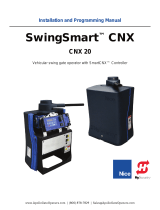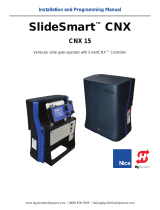Page is loading ...

Swing and Slide Gate Operator UL 325 and
ASTM F2200 Site Planning Safety Checklist
Name:
Address:
City/State/ZIP:
Phone:
Email:
Please Print
ASTM F2200 Standards
Gate Construction Evaluation: Gate Constructed with Safety in mind. ASTM F2200 Standards are followed
Component: Result (Circle) Comments: Figures (On Back)
All Gates
Gates have smooth bottom edges, no protrusions exceed 1/2” beyond base of gate Pass / Fail 5
All access controls at least 6 ft. from gate Pass / Fail 1,4
Barbed tape (razor wire) at least 8 ft. above grade Pass / Fail
Barbed wire at least 6 ft. above grade Pass / Fail
Separate pedestrian gate – out of reach of a moving gate – vehicular gate is
for automotive traffic only Pass / Fail 1,4
Gate does not move on its own if disconnected from operator Pass / Fail
Gates prevented from falling over if disconnected from supporting hardware Pass / Fail
SWING
Distance from pivot point to column edge is less than 4 in. Pass / Fail 4
Distance from open gate to wall or column greater than 16 in. or external
entrapment protection is provided Pass / Fail 4
SLIDE
Roller covers on wheels Pass / Fail 1
Meshing installed up to 6 ft. above grade if pickets spaced equal to or
greater than 2 1/4 in. apart Pass / Fail 3
Gap between gate and fence post less than 2 1/4 in. & gap protected with safety device Pass / Fail 2
Positive stops at both fully open and fully closed positions Pass / Fail 1
Receiver guides recessed behind receiver post for receiver guides less than 8 ft. Pass / Fail
Other: Pass / Fail
© 2018 LiftMaster All Rights Reserved
300 Windsor Drive, Oak Brook, IL 60523
LMSPCLSWSL 4/18
Please Print
First & Last Name of Dealer:
Name of Dealership:
Dealership Address (Street Address/City/State/Zip):
Dealer Signature:
Customer Signature:
First & Last Name of Installer:
Phone:
Installer Signature:
Satisfactory Needs Repair/Replacement
Gate Safety Check — Simple steps to quickly determine if an End User’s gate operator is safe.
UL 325 Standard
Component: Result (Circle) Comments: Figures (On Back)
1. Gate Operator is approved to current UL 325 standards (check operator label) Pass / Fail
2. Proper gate warning signs attached to both sides of gate area Pass / Fail 1,4
3. All entrapment zones protected by 2 safety devices/obstruction tested 1,4
Close Side (circle two) Photo Eye Reversing Edge Inherent Reverse Pass / Fail
Open Side (circle two) Photo Eye Reversing Edge Inherent Reverse Pass / Fail
Other Entrapment Areas Pass / Fail
*Entrapment Zone: The location where an object can be caught or held in a position that increases the risk of injury

GETTING STARTED WITH SWING AND SLIDE GATE OPERATOR.
• Only install the operator on gates used for vehicular trafc.
• A separate pedestrian entry/exit must be clearly visible to promote
pedestrian usage and located so pedestrians do not come in contact
with the vehicular gate while it is moving.
• Install two independent† entrapment protection devices protecting
each entrapment zone.
• Pickets of a slide gate must be designed or screened to prevent
persons from reaching through, or passing through a gate.
• Every Installation is unique. It is the responsibility of the installer to
ensure all entrapment zones are protected with a minimum of two
independent† entrapment protection devices.
• Beginning August 1, 2018, for a slide gate operator to function,
the operator will require a minimum of two independent† monitored
safety entrapment protection devices in each direction: two in the
open direction, two in the close direction.
Always design, install and maintain safe gate access systems in accordance with UL 325 & ASTM F2200 standards.
SLIDE GATE SITE LAYOUT GUIDELINES
SECURE SIDE
PUBLIC SIDE
Be sure to place the
WARNING signs on both
sides of the gate in clear view.
For your records, take a photograph of the
completed installation site.
WARNING
Gap between vertical bars
must be less than 2¼" (57 mm)
Left Hand Gate
opening
Physical stop - at both ends of gate rail.
Photo eye (Emitter or Reector in the Open direction)
Edge sensor
on Trailing Edge
of gate
Pedestrian gate located
near the slide gate.
Mount access control
devices at least 6 ft
(1.8 m) beyond the gate. Make sure a separate walk-
through entrance is available
and its pedestrian path is
clearly designated.
Edge sensor on
Leading Edge of gate
V track
(gate rail)
Physical
stop
Earth ground
Interior posts,
Non-pinch
rollers (2x)
Guide
posts
ENTRAPMENT
NOTE: Any gap larger than 2¼" (57 mm)
between gate and xed objects must be
protected. Install edge sensors where gap
between post and gate creates a draw-in zone.
6 ft (1.8 m) minimum
Photo eye (Receiver)
Photo eye (Receiver)
Photo eye
Emitter or Reector
(Close direction)
ZONE
Edge sensor (Draw-in zone)
SECURE SIDE
PUBLIC SIDE
Pedestrian gate located
near the swing gate.
Make sure a separate walk-through entrance is
available and its pedestrian path is clearly designated.
Mount access control
devices at least 6 ft
(1.8 m) beyond the gate.
Photo
eyes
ZONE
Photo eye
(public side)
Edge
sensor
Earth ground
Reector
for Photo
Eye
ENTRAPMENT
Be sure to place the
WARNING signs on both
sides of the access point in clear view of vehicles.
For your records, take a photograph of the
completed installation site.
WARNING
ENTRAPMENT
Curb
Curb A
View A
Cross Section
ENTRAPMENT
ZONE
Photo eye
(public side)
SWING GATE SITE LAYOUT GUIDELINES
Ed
ge
sensor
ENTRAP
RAPMEN
C
Gate Frame and Adjacent Fence Area
6 ft. minimum
X X XX X XX X X X X XX X XX X X
Gate Frame and Adjacent Fence Area
If gaps (xxx)
between vertical
bars of the gate or
fence are less
than 2 1/4", no
further screening
is required.
For gaps (xxx)
equal to or larger
than 2 1/4", a wire
mesh screen must
be applied to the
gate. Wire mesh
screen openings
must be smaller
than 2 1/4". The
minimum height of
wire mesh screen:
6 ft. above grade.
SLIDE GATE OPENINGS GUIDELINES
Openings of a horizontal slide gate must be smaller than 2 1/4"
or else be guarded or screened. These design rules apply to
both the moving gate as well as the portion of adjacent fence
that the gate covers in the open position. See Illustrations
below.
SLIDE GATE SPACING GUIDELINES
Slide Gate Gaps
A gap, measured in the horizontal plane
parallel to the roadway, between a xed
stationary object nearest the roadway (such
as a gate support post) and the gate frame
when the gate is in either the fully open
position or the fully closed position, shall not
exceed 2 ¼ in.. Exception: All other xed
stationary objects greater than 16 in. from
the gate frame shall not be required to
comply with this section. Any gap must be
protected. Install safety device to protect
draw-in zone.
**Swing Gate Entrapment Zones: Locations between a moving gate or moving, exposed operator components and a counter
opposing edge or surface where entrapment is possible up to 1.8m (6 ft) above grade. Such locations occur if during any point in travel:
a) The gap between the bottom of a moving gate and the ground is greater than 101.6mm (4 in) and less than 406mm (16 in); or
b) The distance between the center line of the pivot and the end of the wall, pillar, or column to which it is mounted when in the open
or closed position exceeds 101.6mm (4 in). Any other gap between a moving gate and xed counter opposing edges or surfaces or
other xed objects is less than 406mm (16 in) (examples are walls, curbs, berms, or other immovable objects).
Definitions
Entrapment: The condition when a person is caught or held in
a position that increases the risk of injury.
Slide Gate Entrapment Zones: An entrapment zone exists if
at any point during travel, the gap between the moving gate
and xed counter opposing edges or surfaces is less than 406
mm (16”) in a location up to 1.8 m (6ft.) above grade.
†Independent the same type of device shall not be utilized for both entrapment protection
devices.
FIGURE 1
The above examples are two of many installation possibilities and are for illustration purposes only.
See device and operator manuals for complete instruction.
Visit DAMSA.com for more information.
FIGURE 2
FIGURE 3
FIGURE 4
FIGURE 5
/

